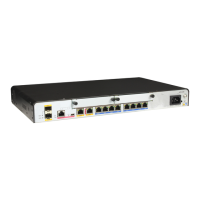No. Data
2 Security profile name or ID and security parameters required
for the specified authentication mode:
l WEP shared key authentication: key value and key ID
l WPA/WPA2 shared key authentication: key value
l WAPI authentication: names of the AC certificate file,
AC certificate issuer's certificate file, and authentication
server unit (ASU) certificate, ASU IP address, and
optional parameters, including: base key (BK) update
interval or lifetime percentage, time-based interval or
packet count-based interval for updating an MBMS
service key (MSK), maximum number of
retransmissions of MSK negotiation packets, and
maximum number of retransmissions of certificate
authentication packets
3
Traffic profile name or ID and optional parameters including
the mappings from user priorities to 802.1p priorities,
mapping from 802.1p priorities to user priorities, and packet
rate limit
4 Service set name or ID, name or ID of the security profile
bound to the service set, and name or ID of the traffic policy
bound to the service set
5 Radio interface number, name or ID of the service set bound
to the radio, and (optional) WLAN index
1.4.2 Configuring a WLAN-BSS Interface
When an AP receives 802.11 radio packets, it uses a WLAN-BSS interface to send the packets
to the WLAN service module. The WLAN-BSS interface is configured with parameters such as
the interface priority and authentication mode.
Context
A WLAN-BSS interface is a virtual Layer 2 interface. Similar to a Layer 2 Ethernet interface
of the access type, a WLAN-BSS interface has Layer 2 attributes and supports multiple Layer
2 protocols.
After creating a WLAN-BSS interface, bind a service set to the interface.
Procedure
Step 1 Run:
system-view
The system view is displayed.
Step 2 Run:
interface wlan-bss wlan-bss-number
Huawei AR1200 Series Enterprise Routers
Configuration Guide - WLAN 1 WLAN Configuration
Issue 03 (2012-01-06) Huawei Proprietary and Confidential
Copyright © Huawei Technologies Co., Ltd.
12

